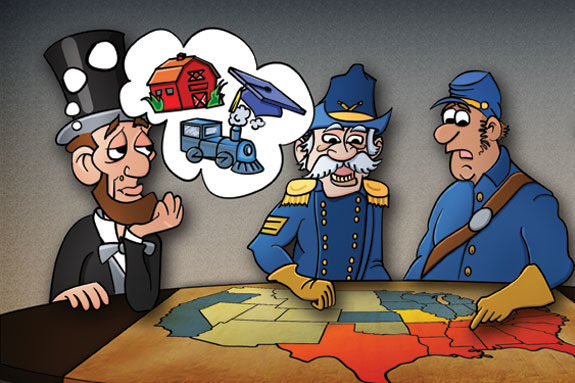One year into the Civil War, the Union cause was not going as well as the early swagger had promised. Gen. McClellan failed to take Richmond and gave up an opportunity at Antietam to inflict a heavy blow on the Confederacy. Lincoln had finally given up on his top general and canned him in March of 1862. Meanwhile, General Lee was still a desk general advising Jefferson Davis in Richmond. But on May 15, 1862, while rebel forces at Drewery’s Bluff successfully stopped the Union navy from attacking Richmond via the James River, Abraham Lincoln signed a statute creating the Department of Agriculture.
Thousands of books, articles, speeches and presentations discuss the battles, skirmishes and strategies during the period of 1861 to 1865. But these were not the only defining moments of the period.
Congress and the president, in the midst of carnage and tragedy, pursued an expansive domestic agenda as well. Lincoln supported the Homestead Act that gave land to individuals, expanded the rail system across the Continent and created land-grant colleges.
All of these had long-term impact on American agriculture.
The land grants ensured that farm ground would be held in productive units among a large number of people, not a few owning everything – the expansion of the rail system meant products produced in the middle of the country could make it to markets elsewhere – and the land-grant college system established a network of research, training, education and outreach that advanced agricultural practices far beyond where they were at the beginning of the war.
These Civil War domestic policies still resonate today.
That agriculture benefitted so much from domestic policies is because, at the start of the war, America was an agrarian population. In simplistic, but not inaccurate terms, it was the dependence on agriculture in the South and its model using slave labor that created the divide that led to the war.
Three-fourths of the population lived in rural areas and small towns. So tied to agriculture was America that Lincoln called the newly formed department the “People’s Department.”
Agriculture was not limited to rural areas. Even in urban areas, individuals had gardens, raised chickens, milked cows and raised other livestock. A few days after Lincoln signed the act, a fire broke out at the S.L. Husted & Son Distillery in Brooklyn, New York, killing the cows in its stables, who fed on the mash. The fire spread to other nearby “swill-milk” stables.
The use of mash to feed cattle and the quality of milk coming into New York City was considered an ongoing scandal. In 1870, Central Park’s plans called for a dairy barn to be located there to provide quality milk for the children of the city. In Washington, D.C., cows grazed on the National Mall while Union troops camped, and towns throughout the nation saw sheep and cattle graze on their commons and malls.
The milk delivered to the cities was often unwholesome. Filled with chalk, water and other fillers and infected with bacteria, consumption often brought outbreaks of typhoid, tuberculosis and cholera. The control of quality at that time was a city or local health department issue. There were no federal milk quality standards or inspections.
Production of fluid milk for the market was rare. Most farmers either consumed the milk themselves or made cheese and butter for sale to the market. The efforts to move milk product manufacturing from the farm to factories had barely begun.
Just before the war, Borden had perfected the making of canned condensed milk. During the war, canned milk provided a nutritious and safe ration to the soldiers. At the end of the war, they carried its story back home.
This higher-quality and safer product furthered expansion of condensed milk production and a demand for fluid milk from farmers. H.P. Hood began his commercial dairy 10 years prior to the war, supplying Boston and surrounding populations. Borden and Hood were exceptions at the time.
In its early years, the USDA’s role with agriculture was primarily geared to research and education. After the Civil War, the agrarian movement began in the Midwest, resulting in more laws and regulations favoring farmers – from elevator fees to transportation costs to banking regulations. Cooperatives began to form, often in opposition to existing law, and expand.
Broader regulatory authority came in the early 20th Century as a more urban population demanded greater food safety and tighter standards for the food they no longer produced themselves but purchased. The Progressive movement expanded the authority. The legalization and promotion of agricultural cooperatives took place early in that century.
The USDA took a leading role in developing the cooperatives by providing needed advice and services. Among the programs still in effect today is the Capper Volstead Act, which gives the secretary authority to determine if the consolidation of farmers is unfairly changing prices.
For a short period during Calvin Coolidge’s administration, with its hands-off approach, this growth in regulatory reach slowed and stopped. The real growth of the federal government in agriculture predated Franklin Roosevelt and the New Deal in the Hoover administration.
Herbert Hoover was committed to using the federal government to intervene in farm pricing. He created the Farm Board, with broad authority and a huge budget to intervene in the market place to improve farm prices. It was the disaster of the Farm Board and resulting counter-legislation of Smoot-Hawley Tariffs that many believe was the precipitator of the Great Depression.
During the Hoover administration, the central portion of the Whitten Building – where the secretary has his office today – was completed and the massive South Building was started. The size of this building, designed and built before the New Deal farm programs, shows just how mammoth the USDA had already become under Hoover.
Franklin Roosevelt expanded federal involvement in agriculture beyond Hoover’s intrusion. Under the first Agriculture Adjustment Act (AAA), a companion to the National Industrial Recovery Act, Roosevelt proposed licensing dairies and other farmers. Processors were taxed and the money used to reduce production.
The Supreme Court, in U.S. v. Butler , held that congressional authority over interstate commerce did not include authority over manufacturing or retail. It held the AAA unconstitutional. In its place came the Agricultural Marketing Agreement Act, which authorized the federal milk marketing order system, still used today to regulate milk prices.
Government involvement went beyond research and milk pricing into what had been local programs in setting product standards, promoting food safety and higher quality. Though fluid milk is now subject to FDA regulation, inspection of manufacturing grade facilities and products remains with the USDA.
To regulate requires measuring. The USDA, through the National Agricultural Statistics Service, Agricultural Marketing Service, Economic Research Service and other agencies, collects, compiles and analyzes enormous amounts of data permitting farmers, processors, politicians and professors to take all kinds of pulses of the industry.
The USDA has administered direct payment to the industry through the dairy price support program, the herd reduction and herd buyouts of the 1980s and direct payments, including the current MILC program.
The USDA also administers programs, non-dairy-specific, that also benefit dairy producers. These include conservation programs, loans and loan guarantees, grants to develop and maintain the infrastructure in rural America, work with cooperatives, research on production, disease and genetics.
Not the least of this is the work by Animal and Plant Health Inspection Services, APHIS, in herd disease reduction and elimination. Programs to reduce brucellosis, bovine TB, hoof-and-mouth disease and other diseases have benefitted dairy farmers, with healthy animals, and the public, with a safer product.
So big is the USDA that on any given day someone within its employ is researching ways to increase milk production, increase demand for more dairy in other products and promote the use of dairy products, and elsewhere someone ponders programs to limit overall milk production and the consumption of dairy, particularly fat, in human diets.
Today the budget of the USDA is an estimated $132 billion dollars administered by over 100,000 employees. The war Lincoln oversaw cost over $6 billion, with pensions adding another $10 billion. At the start of the war, the federal government employed only 36,000 civilians, mostly postal workers.
Change needs to come. Agriculture, especially dairy, has changed dramatically. No longer are there dairy farms in our cities – rather large trucks bring in both raw and finished product. The quality is unsurpassed, making it the safest food on the planet.
Several average dairy farmers today deliver almost as much milk as was delivered to New York City in the 1860s. No longer do cows graze on commons or the malls.
While the USDA administers programs for a tiny portion, 1 or 2 percent of the population, the fruits of its labors certainly ensures that Americans have an abundance of the safest and least-costly food on the planet and, in that way, it remains the People’s Department. PD

Ben Yale
Yale Law Office







